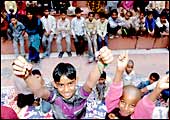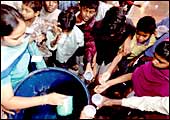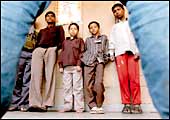|
NOVEMBER 23, 2005; 9.00
A.M.
Venue: August Kranti Bhavan,
Bhikaji Cama Place, New Delhi
It
looks like a scene from a boys' school. Hundreds of 10-14 year
olds are playing games in the cavernous courtyard. Some are playing
frog race, others are simply running around, while the rest are
excited spectators. There are high-decibel whoops of joy and despair
as the games reach a fever pitch. But something's wrong. I can't
quite put my finger on it at first; but as I keep watching, it
suddenly hits me like a slap on the face. All the children look
emaciated. But why am I surprised? This is no school I'm visiting;
till yesterday, these kids were virtually bonded labourers.
Games over, the kids queue up for a photo
shoot; not the regulation Children's Day photo op; the boys are
being profiled before being produced before the Office of the
Child Welfare Committee under the Department of Social Welfare,
Government of Delhi, at Lajpat Nagar in the Capital. There are
about 500 of them-all rescued the previous day from dark, dingy
slums in East Delhi where they worked in the zari trade. It is
one of the Capital's worst kept secrets: thousands of children
work in sub-human conditions from morning to midnight, with hurried
breaks only for a meal or two. Asks Zunaid Khan, Head of Pratham,
the NGO that coordinated their rescue: "We gave the police
a list of over 2,000 children. Where are the rest?"
 |
| The saviour with his flock:
Zunaid Khan, Head, Child Unit, Pratham, with some of the
children rescued by the police |
Almost 90 per cent of the boys hail from the
Sitamarhi district of Bihar. This region is steeped in poverty;
it has no industries; most inhabitants are illiterate and a majority
of families have seven to eight children. Result: many families
have no choice but to send their children away to Mumbai, Delhi
or Surat to work as child labourers. They are stepping out of
the frying pan into the fire, but grinding poverty makes any alternative
seem attractive.
Mohammad Saddam, 14, one of the rescued children
is inconsolable. "Who will feed my family now?" he wails.
Saddam has four brothers, three sisters and his mother to support.
His rescue by the Pratham-police combine means he can no longer
send money home. Gulista Rajput, Co-ordinator, Pratham, notices
my consternation. "These kids have lost their childhood,
burdened as they are by the responsibilities of feeding their
parents and their families," she says.
And the unpalatable truth is that rescue operations,
such as the one co-ordinated by Pratham, don't usually work. Says
Mohd. Tufail, 12, another child worker: "The police rescued
us from a zari factory in Mumbai two years ago, put us in a big
hall, fed us for two months, and sent us all home to Sitamarhi."
Why did he return to the trade, this time in Delhi? "Garib
hoon. Kya karega? (I'm poor. What's the alternative?)" he
asks. The answer hits me like a whiplash. These children-once
trained-can earn anything from Rs 800 to Rs 3,000 a month; that
money can make the difference between starvation and life back
home.
 |
 |
| The will to survive: In spite of working
in sub-human and obnoxious conditions, these children can
still smile |
No hurried break this: All these children
are responsible for feeding their poor and large families
back home |
Piyush Sharma, Joint Labour Commissioner,
Delhi, estimates that the National Capital Region alone has 50,000
child labourers (including domestic helps). Laws like the Factories
Act, 1948, and Child Labour Regulation and Prohibition Act, 1989,
expressly prohibit the employment of children below the age of
14, while the Delhi Shops & Establishment Act, 1954, bans
the employment of children below the age of 12 years. These laws
provide for fines of Rs 1 lakh and imprisonment of one year, but
prosecutions are rare.
In the instant case, about 50 small operators
have been identified as the culprits. Sharma assures me that the
guilty will definitely be punished. Interestingly, no exporter
has been linked to any of these offending units. Says Vijay Mathur,
Secretary, Apparel Export Promotion Council: "us and European
buyers are demanding strict compliance to ethical workplace practices."
Decoded, this means the slightest hint of child labour can cause
irreparable damage to an exporter's plans of tapping these two
markets. The example of the carpet weavers of Uttar Pradesh is
still fresh in the memories of the exporting community.
 |
| Stunted: Parmod Kumar (left)
and Mohammad Naeem both claim to be in their mid-teens, but
look half their age |
But the domestic market is at least three
times the size of the export pie. And there's no Damocles' Sword
hanging over suppliers who feed this huge market. This creates
a huge demand for kids like Saddam and Tufail. Adds Sharma: "The
unfortunate truth is that there is an abundance of child labour
in the market. The moment they grow up and start demanding their
dues, they are replaced by other children." And what do they
do once they grow up? Almost all the kids dream of becoming seths
(factory owners) some day. There are plenty of apocryphal rags
to riches tales doing the rounds, serving as morale boosters for
these kids. But is there any grain of truth in any of them? No
one can tell me for sure.
For now, these rescued children will be released
by the Child Welfare Committee to their parents. The Magistrate
of their local districts will monitor their progress under the
government's primary education programme, Sarva Shiksha Abhiyan.
And the Delhi government has written to companies like Maruti
Udyog and Bajaj Auto to train adolescents in their facilities.
Will their rehabilitation work this time
around? I hope so. Then why am I getting that sinking feeling
in my stomach?
|








